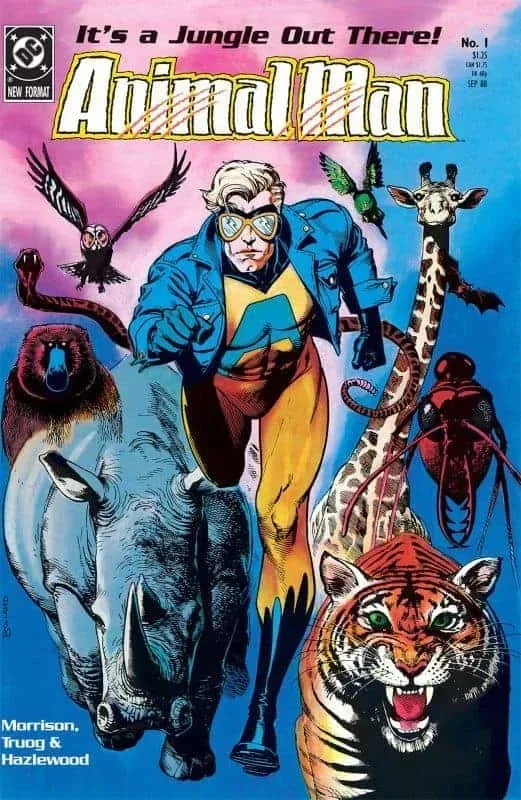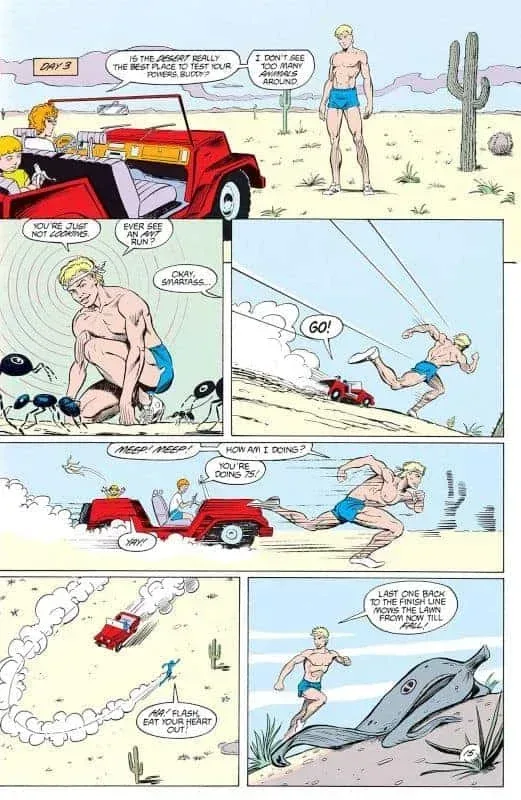
Most people aren’t really aware how much Crisis on Infinite Earths changed during the 1980s. DC Comics’ first major crossover event not only unified all of its previous stories, it completely revamped the whole universe, allowing future writers to focus on new stories set within a single narrative universe. Of course, the concept did not last and the Multiverse is practically a necessity for modern comic books, but it was quite influential back at the time. One of the consequences of the Crisis events was a revamp of DC’s old characters and stories, including the Swamp Thing, the Sandman, and – Animal Man. The latter is going to be the topic of my article!
Grant Morrison’s 1980s run on Animal Man is one of the better revivals that we had the pleasure of reading, which is why people generally agree on the fact that it is definitely worth the read.
In today’s article, I am going to reveal all the necessary information you have to know if you plan on reading Animal Man. I am going to tell you what the series is about, whether it is worth your time, and where you should start with the series. Enjoy!
What is Animal Man about?
The Animal Man stories begin with the American Bernhard “Buddy” Baker finding a crashed spaceship. Immediately afterward, the hero realized that through contact with the extraterrestrial vehicle he has acquired the amazing ability to temporarily acquire and use the properties and abilities of every animal known to him through mere concentration.
The animal skills he uses include the skills of dinosaurs (strength), skunks (stench), electric eels (electricity), worms (regrowing lost body parts), birds (flight), fish (swimming), and snakes (agility). This was the classical Animal Man as portrayed in the several stories he has appeared in during the 1960s. Things, of course, changed in the 1980s, when Morrison took over the post-Crisis on Infinite Earths version of the character as it debuted in 1988.
The modern Animal Man created by Morrison differs noticeably from the type of “standard superhero”, which is, as you are going to see in the next section, one of the issues tackled by Morrison during his run on the Animal Man comic book.
Namely, unlike most other (mainstream) superheroes, who are childless bachelors (okay, I know that it isn’t the standard anymore as even Batman got a kid eventually, but it was the standard of the time), Buddy Baker as envisioned by Morrison, has a wife, Ellen, and two children, a son named Cliff and a daughter named Maxine.
The plot of Morrison’s run on Animal Man was very clearly full of moral dilemmas and political issues close to Morrison and his usual narrative style. For example, Morrison lets the title hero propagate the vegetarian way of life and, as an advocate for animal rights, take very far-reaching steps in that direction.
For example, in one of Morrison’s many stories, Animal Man helps a group of self-declared ecoterrorists to attack a fleet of dolphin hunters, which was quite atypical for the time, as superheroes never helped terrorists, regardless of their ideologies. In that same storyline, Animal Man also let one of the fishermen, whose cruelty towards the animals made him particularly sick, drown but as fate would have it in an ironic twist, the fisherman ended up surviving thanks to the help of a dolphin, the same animal he had so mercilessly hunted down.
Most of the post-Morrison stories were similar to this one in style and subjects.

Is Animal Man worth reading?
Animal Man is certainly one of the more interesting revival titles that DC Comics published in the post-Crisis era. It might not be as interesting as Alan Moore’s work on the Swamp Thing or Neil Gaiman’s majestic work on The Sandman series, which I have already written about earlier, but Grant Morrison’s 80s run on Animal Man was more than enough for us.
Grant Morrison focused on several important and revolutionary topics such as social consciousness (with a specific focus on animal rights), metaphysics, deconstruction of the superhero genre and comic book form, postmodernism, eccentric plot twists, explorations of cosmic spirituality and mysticism, the determination of an apparent free will by a higher power, and manipulation of reality including quantum physics, unified field theory, time travel, and metafictional technique.
All of these elements have made Animal Man a very challenging piece of comic book artistry and I must admit that I had fun reading it. Although later volumes never really captured Morrison’s unique vision in full, they have successfully built on Morrison’s strong foundations and that is what made Animal Man a cult classic in a way, and why I think that it is definitely worth a read.
Where should you start with the Animal Man comics?
Animal Man is a character that debuted in 1965 but he never had his own comic until Morrison took over the series in 1988. The initial character was never popular enough to merit a proper series so DC Comics just used him in a certain number of stories, but they never really put much money on the character. First of all, he wasn’t all that worked out during the 1960s and the whole concept wasn’t really something that Golden Age readers wanted to read on a regular basis. That is why Animal Man fell into oblivion.
The situation changed in 1988 when Grant Morrison took over the character. He rewrote him so well that DC Comics gave Animal Man a proper, standalone series that ran from 1988 to 1995, i.e., several years after Grant Morrison left the project. Sure, Animal Man never became Batman or Superman in terms of the series’ popularity, but it was popular enough for DC to publish 89 regular issues and one annual during these seven years.
DC Comics revived the series in 2011, when it ran until 2014, totaling a total of 30 issues and two annuals. In that context, if you plan on reading Animal Man, feel free to start off with Morrison’s #1 and continue until the last issue of the 2011 series.
